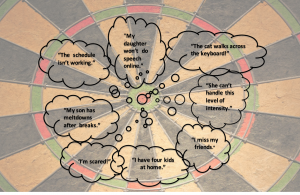There’s no rule book on how to simultaneously tackle a lost job, how to educate children at home, pay bills, and stay healthy and sane amidst a pandemic. New realities warrant plausible solutions to stay on target to achieve goals.
 Yes, there are challenges, however there are also creative and evidence-based strategies and interventions. These five tips offer ways to circumvent negativity, stagnation, instability, regression, and depression. Yes, we hate it all, but onward, please!
Yes, there are challenges, however there are also creative and evidence-based strategies and interventions. These five tips offer ways to circumvent negativity, stagnation, instability, regression, and depression. Yes, we hate it all, but onward, please!
 Tip One: Establish Positive Attitudes
Tip One: Establish Positive Attitudes
“Can do and will do” attitudes are nonnegotiable. Individual and or group panic is never a productive option. Think and communicate “better horizons ahead” for yourself and children. Keep family gratitude journals that house positive sentiments. Concentrate on flowers that bloom and the music in our world. Focus on solutions. whether that’s more frequent hand washing, task analysis to increase positive behaviors, having video playdates, or connecting virtually with teachers, family, and friends. Different, but onward.
 Tip Two: Help, Don’t Enable
Tip Two: Help, Don’t Enable
Goldilocks said it best, but what does “just right” look like in a pandemic? Supports need to help, but not enable children or families. Instead of spoon-feeding answers, provide the resources and tools that lead to discovery. That includes a “do-it-yourself semi-supervised cooking lesson,” providing a link to a math video tutorial, offering science visuals for more difficult vocabulary, or asking a child to tally his or her progress. Monitor frustrations, but help, do not enable. Goal is to target learning and self-efficacy.
Tip Three: Plan & Prepare
Proactivity is crucial for “what-if” scenarios. If online connectivity is lost, prepare alternate activities. As age-and interest appropriate, kids can color, read a comic book, listen to music, post an Instagram, or perhaps call their grandmother. If a child has a meltdown, provide sensory items and procedures to soothe and regulate. That might mean looking at a montage of family photos, counting to ten or twenty, listening to or reading a book, or pounding some clay. Having consistency with schedules is important, but expect the “curveballs.” If the cat walks across the keyboard, it’s ok to laugh, but then it’s back on track to avoid a total derailing. In challenging times, honor the distractions, but offer redirections with planning and preparation for “children of all ages.”
Tip Four: Balance
Evenly distributing our weight is tough to do, whether we’re trying to stand like a tree in a yoga pose or juggling difficult agendas. Unprecedented times require managing “wobbly” behaviors and emotions. It’s important to learn, but in healthy doses. Balance textbooks and screen time with fun times, like teaching the dog a new trick, stretching, learning a new language, playing a video game, or creating a watercolor, haiku, or animated video. Acknowledge and validate emotions, but balance academics and emotions.
Tip Five: Breathe & Smile
 Deep breaths lower stress levels and offer positive connections to internal organs and glands. Although we can receive a message to “breathe” on a device, we need to regularly “message ourselves” to continually take deep breaths of inhalation and exhalation. Mindfulness leads to coping strategies. Upturned lips are difficult to see, but masks don’t mask smiles.
Deep breaths lower stress levels and offer positive connections to internal organs and glands. Although we can receive a message to “breathe” on a device, we need to regularly “message ourselves” to continually take deep breaths of inhalation and exhalation. Mindfulness leads to coping strategies. Upturned lips are difficult to see, but masks don’t mask smiles.
Together WE CAN and WILL!
Namaste.
